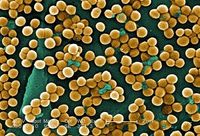Staphylococcus aureus: USA:300: Difference between revisions
| Line 4: | Line 4: | ||
==Classification== | ==Classification== | ||
[[File:MRSA300x204.jpg|200px|thumb| | [[File:MRSA300x204.jpg|200px|thumb|right|<i>S. aureus: USA300</i> Golden clusters]] | ||
Domain: <i>Bacteria</i> | Domain: <i>Bacteria</i> | ||
Revision as of 03:40, 26 October 2011
A Microbial Biorealm page on the genus Staphylococcus aureus: USA:300
Classification
Domain: Bacteria
Phylum: Firmicutes
Class: Bacilli
Order: Bacillales
Family: Staphylococcaceae
Genus: Staphylococcus
Species: S. aureus
(Strain: USA:300)
Description and significance
Staphylococcus aureus: USA:300 is a strain of gram-positive coccus bacteria responsible for Methicillin-resistant Staphylococcus aureus (MRSA), or Staph infection in humans. This strain of S. aureus is resistant to β-lactam antibiotics. When cultured, this bacteria appears as golden clusters. The golden color is the result of a carotenoid pigment that protects the bacteria against host-immune system reactive oxygen species, and adds to the bacteria's virulence. S. aureus is a facultative anerobe, which can be found in a wide variety of locations such as soil, human skin, and public places like hospitals and prisons. This strain of S. aureus: USA 300 was first identified in 1998, and is thought to be the primary causal strain of community-acquired Staph infections throughout the United States, Canada and Europe. In 2006 the CDC reported that 64% of MRSA isolated from infected patients were of the USA 300 strain. This bacteria contains the cytotoxin Panton-Valentine leukocidin (PVL), which targets leukocytes. It also contains modulin, which is a phenol-soluble peptide (PSM) that is capable of lysing neutrophilic granulocytes. These toxins cause rapidly-progressing fatal conditions such as necrotizing pneumonia and faciitis and severe sepsis.
Genome structure
Describe the size and content of the genome. How many chromosomes and plasmids? Circular or linear? Other interesting features? What is known about its sequence?
Cell structure, metabolism & life cycle
Provide a physical and biochemical description of the organism. What kind of organism is it, what does it look like, how is it built, what are its metabolic properties, how can it be identified, what is it's life cycle, &c. In other words, describe the organism from its perspective.
Ecology (including pathogenesis)
Describe its habitat, symbiosis, and contributions to environment. If it is a pathogen, how does this organism cause disease? Human, animal, plant hosts? Describe virulence factors and patient symptoms.
Interesting feature
Describe in detail one particularly interesting aspect of your organism or it's affect on humans or the environment.

